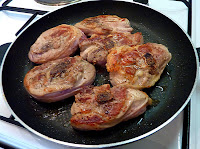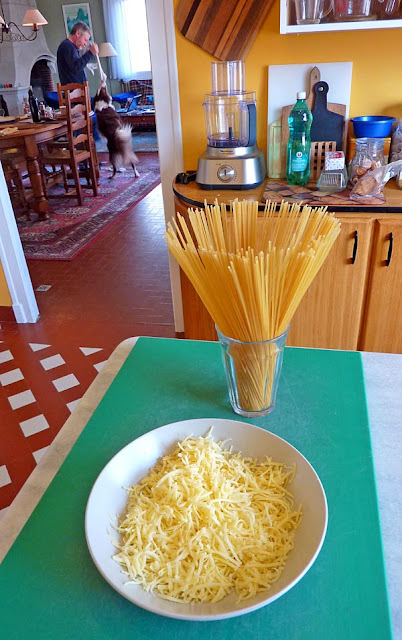Our friends in Blois had us over for lunch yesterday. They are officially elderly — in their late 70s and early 80s. In some ways, it was like going back thirty or forty years in time, I thought. And in other ways, it was just like being here in Saint-Aignan in 2013.
For example, M. and B. still talk about large sums of money in French francs rather than in euros. And they don't give amounts in what were known as "new francs" but in "ancient" francs — old francs, or anciens francs. M. said that they have spent « un million cinq cent mille » on car repairs since Christmas. That's 1,500,000. "Old francs" is understood.
These kinds of linguistic idiosyncrasies make even the most mundane everyday conversations in a language which is not your native language difficult to keep up with. It takes many years of familiarity with the language (vocabulary, grammar, idioms, pronunciations), as well as with the history and culture of the country, to get it all worked out in your mind.
At the same time, as an American you also have to learn to convert temperatures expressed in degrees Celsius back into Fahrenheit, weights in grams and kilograms into pounds and ounces, and lengths and distances in centimeters, meters, and kilometers back into inches, feet, yards, and miles. It really makes your head spin.
Who thought old and new francs would still be an issue more than 10 years after the adoption of the euro currency? Hearing prices quoted in old francs reminds me that I already found it complicated to deal with old and new francs back in the 1970s, and now there's an added layer, the euro. And of course, I still need to translate to dollars in my head at certain points to judge the values and sums being discussed.
What were anciens francs and how did new francs come into being? The old franc was the French currency of the 1950s and earlier. What happened was that after the 1940-45 war, France experienced a decade or more of economic and political instability during which inflation roared along. The value of the franc declined precipitously, to the point where a million old francs was an amount people had to deal with in everyday life.
When General de Gaulle was pressed into service to try to rescue France from turmoil in the late 1950s, one of the reforms he instituted was the new franc. It was pretty simple. The government declared that 100 old francs would henceforth be called one franc. The old franc suddenly had the value of a centime, or a penny. Even in the 1970s, when a beggar or panhandler on the street in Paris asked you if you could spare a (new) franc, he would say: « T'as pas cent balles ? » Balles was a slang word for francs.
It was as if somebody in America was asking you for 100 pennies instead of saying a dollar. (The American panhandler's expressions were "Got any spare change?" or, older still, "Buddy, can you spare a dime?") Back in the 1970s, first I had to learn what balle meant, and then I had figure out why somebody was asking me for a hundred of them. As a starving student, I didn't have that kind of money, I thought.
But I did, really, because 100 (old) francs had become 1 (new) franc in the 1960s. Everybody I knew in Paris still talked in terms of old francs, but prices were posted everywhere in new francs, which was the official currency. French friends my age or younger would say that some little item they'd bought had cost them mille balles or deux mille balles or cinq mille balles, meaning 10, 20, or 50 francs.
The new franc was worth about 20 cents in U.S. dollar terms. One dollar was worth five francs, or 500 balles. So cent balles (a hundred) was less than a U.S. quarter. Mille balles (a thousand) was two dollars. Five thousand balles represented 10 dollars. People my age used the slang word balle instead of the word franc to make it clear they were talking in old instead of new francs. In magazine and newspaper articles, you would see large amounts written as, for example, un million de centimes, meaning "a million pennies" or 10,000 new francs. In U.S. terms, un million d'anciens francs was two thousand dollars.
When we asked our 78-year-old host yesterday about her quoting of prices in old francs, she said that amounts in euros still don't have any real meaning for her. Prices in the supermarkets are still displayed in (new) francs as well as in euros, by the way. M. translates those prices into old francs in her head, she says, so that the amounts have meaning for her. When she said she and B. had spent "a million and a half" (anciens francs) on car repairs since Christmas, she was talking about more than two thousand euros, or nearly three thousand dollars. Well, it is a BMW...
I did the math with a calculator last night and found that the old million d'anciens francs is still worth pretty much exactly two thousand dollars, at today's exchange rate. Nothing's changed, really.
For lunch, M. and B. served a pot au feu. That's a boiled beef dinner with winter vegetables including carrots, leeks, turnips, and potatoes. Coincidentally, Walt and I had made a pot au feu on Monday, and we've been eating leftovers for a few days now. We are having a beefy week. M.'s pot au feu was excellent. The meat she used was joues de bœuf — beef cheeks.
Coincidentally again, on Tuesday, I bought a kilogram (2¼ lbs.) of beef cheeks from the drive-up butcher. My plan is to make a beef stew — bœuf bourguignon or bœuf aux carottes — with the cheeks. Not right away though. I've put the joues de bœuf in the freezer for now. We wouldn't want to start mooing around here.




















































